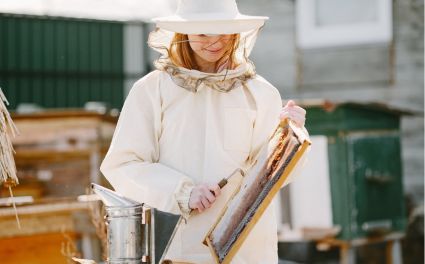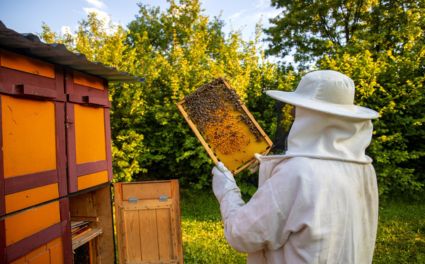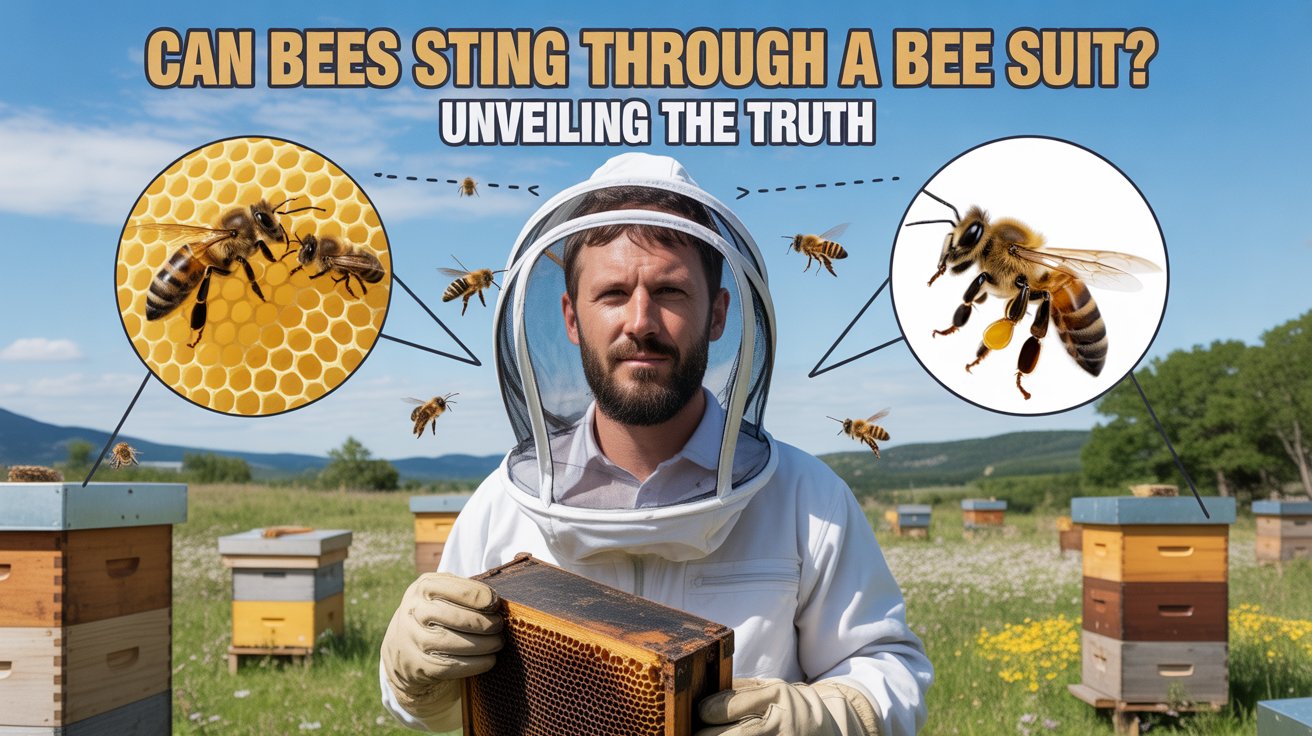Can bees sting through a bee suit? This common question highlights the importance of protective gear for beekeepers. Whether you’re inspecting hives, collecting honey, or tending to your colony, bee suits are the first line of defense against painful stings. While these suits offer substantial protection, their effectiveness depends on design, materials, and maintenance.
This detailed guide explains how bee suits work, their components, and how high-quality beekeeping equipments can make your beekeeping experience safer and more enjoyable.
🧥 Understanding Bee Suits
Bee suits are specialized protective clothing designed to shield beekeepers from stings. They form a crucial barrier between the skin and defensive honey bees, allowing for safe hive inspections. To fully appreciate their role, it’s essential to understand the components, materials, and fitting of a complete beekeeping outfit.
Components of a Bee Suit
🕶 Veil
The veil is the most critical component of a bee suit. It covers the head and face with fine mesh, ensuring clear visibility and breathability while keeping bees at a safe distance. A properly designed beekeeping veils prevents bees from getting close to the skin, reducing the chance of stings near sensitive areas.
🧥 Jacket or Full Suit
Beekeepers can choose between a protective beekeeping jackets or a complete beekeeping suits depending on their work environment. Jackets offer upper-body coverage and are lighter for short inspections, while full suits provide head-to-ankle protection for maximum safety during intensive hive work.
🧤 Gloves
Beekeeping gloves protect one of the most vulnerable areas — your hands and wrists. These gloves are typically made from durable leather or synthetic materials that balance flexibility with sting resistance. They allow beekeepers to handle frames and tools confidently without sacrificing dexterity.
👖 Trousers
When using a jacket rather than a full suit, beekeeping trousers are essential. They safeguard the legs and ensure bees cannot crawl underneath clothing. Elasticated cuffs or zippers around the ankles help create a sealed barrier against curious bees.
🧒 Beekeeping Kids Suits
Young beekeepers or those learning under supervision can benefit from beekeeping kids suits. These smaller-sized suits offer full-body protection and allow children to participate safely in educational apiary activities.
🦶 Ankle Protection
Many stings occur near the ankles where trousers meet boots. High-quality beekeeping ankle protection ensures no gaps exist at these vulnerable points.

🧵 Material Choices for Bee Suits
Cotton
Traditional bee suits were often made from thick cotton. While breathable and comfortable, cotton can allow occasional stings if it clings to the skin. It remains a popular choice for hobbyists working in cooler climates.
Synthetic Blends
Modern manufacturers like OZ Armour use advanced polyester and nylon blends that improve durability and sting resistance while keeping suits lightweight. These materials are also easier to clean and maintain, an important factor for frequent beekeepers.
Ventilated Mesh Suits
Ventilated suits combine multiple layers of breathable mesh that prevent direct skin contact. The air gap between layers acts as a buffer, making it almost impossible for stingers to reach the skin. Such designs are ideal for beekeepers working in warm climates.
👌 Importance of a Proper Fit
Even the best materials can’t protect you if the suit doesn’t fit correctly. A well-fitted bee suit prevents gaps around wrists, ankles, and the neckline — all common entry points for bees.
When purchasing a suit, beekeepers should check:
-
Elastic or zipper closures at cuffs and ankles
-
Veil attachment that seals securely with no gaps
-
Freedom of movement for bending and lifting hive boxes
A properly fitted bee suit offers protection and ensures comfort and flexibility during long inspection sessions.
🐝 Bee Stings and Bee Suits
The Anatomy of a Bee Sting
Bees sting to defend their hive. A stinger has tiny barbs that anchor it in the skin, injecting venom that causes pain and swelling. Honey bees die after stinging because their barbed stinger detaches — unlike wasps, which can sting repeatedly.
Why Bees Sting
Bees usually sting in defense — protecting their queen or reacting to perceived threats like vibrations, noise, or sudden movement. Calm, patient handling and smoke application reduce agitation during hive inspections.
Also read: How Does a Bee Sting Work?
🧱 Can Bees Sting Through a Bee Suit?
Bee suits are highly effective but not completely sting-proof. Under specific conditions — such as thin fabric, tight contact against skin, or small tears — a sting might penetrate. However, with quality gear and careful beekeeping practices, the likelihood is minimal.
Here’s what influences sting resistance:
-
Fabric Type and Layers
-
Thicker or triple-layer ventilated materials (like those used in OZ Armour suits) significantly reduce sting penetration.
-
Multi-layer designs create a physical gap that prevents stingers from reaching the skin.
-
-
Suit Condition
-
Tears, loose zippers, or worn fabric weaken protection. Regular inspection and timely replacement of parts are essential.
-
-
Fit and Sealing
-
Stings often occur when bees slip through gaps at cuffs, ankles, or collars. Proper sealing and ankle protection minimize these risks.
-
-
Bee Temperament
-
Calm colonies are less likely to sting. Using smoke strategically and avoiding strong perfumes or rapid movements helps maintain peace.
-
🧽 Maintaining Your Bee Suit
Proper maintenance ensures the longevity and sting resistance of your protective gear.
-
Regular Cleaning: Wash suits gently to remove propolis, sweat, and bee scent — bees are sensitive to smells.
-
Inspect for Damage: Check seams, veils, and zippers after every use. Small tears should be repaired immediately.
-
Storage: Store your suit in a dry, cool place away from direct sunlight to prevent material degradation.
Beekeepers also keep additional beekeeping equipment such as smokers, hive tools, and brushes clean and in good condition to maintain overall safety and efficiency.
🧤 Additional Protective Gear
Beyond the main suit, accessories play a major role in overall safety.
-
Beekeeping Gloves: Protect your hands while allowing precise hive work.
-
Beekeeping Veils: Prevent facial stings during inspections.
-
Beekeeping Jackets: Ideal for quick hive visits.
-
Beekeeping Trousers: Pair with jackets for full lower-body protection.
-
Beekeeping Kids Suits: Safe, fun introduction to beekeeping for young learners.
Each of these components, when combined, offers full-body protection and confidence while working with bees.
🌿 Bee Behavior and Safe Practices
Even with top-tier gear, good beekeeping behavior matters:
-
Approach hives calmly and avoid loud sounds.
-
Always wear full protective gear.
-
Use smokers to reduce defensive reactions.
-
Avoid synthetic fragrances and dark clothing.
Consistent calm behavior helps maintain a peaceful environment for both bees and beekeepers.

🌸 Final Thoughts
Bee suits are vital for anyone working around bees — from hobbyists to professional apiarists. While no protective gear is entirely sting-proof, a well-designed suit combined with the right techniques drastically reduces risk.
Brands like OZ Armour exemplify innovation in protective design, offering ventilated, lightweight, and sting-resistant options tailored to different climates and skill levels.
For complete protection, pair your bee suit with gloves, veils, trousers, and ankle protection. With proper care and respect for bee behavior, stings become rare — allowing you to focus on the rewarding experience of beekeeping.
To keep learning about hive care, honey extraction, and protective gear, check out read more blogs about beekeeping and explore professional-grade beekeeping equipment for a safe, enjoyable journey in the world of bees.



